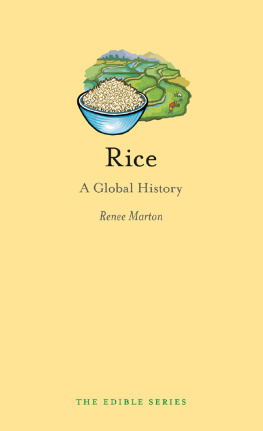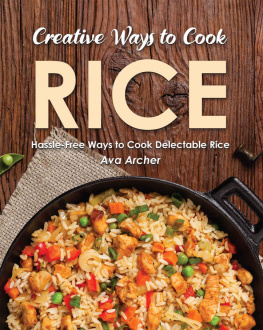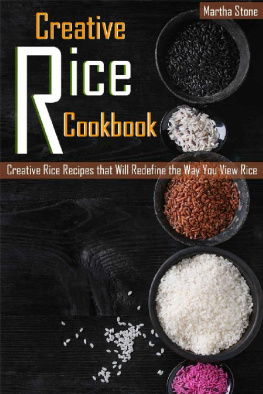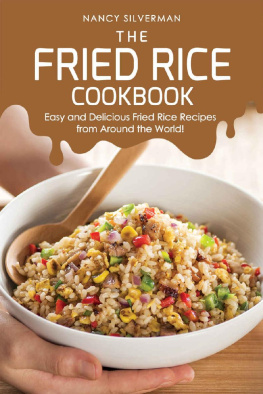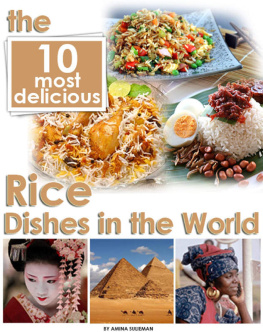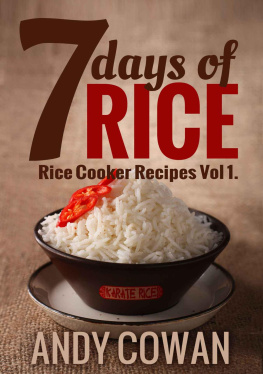RICE

Edible
Series Editor: Andrew F. Smith
EDIBLE is a revolutionary series of books dedicated to food and drink that explores the rich history of cuisine. Each book reveals the global history and culture of one type of food or beverage.
Already published
Apple Erika Janik Barbecue Jonathan Deutsch and Megan
J. Elias Beef Lorna Piatti-Farnell Beer Gavin D. Smith
Brandy Becky Sue Epstein Bread William Rubel Cake
Nicola Humble Caviar Nichola Fletcher Champagne Becky
Sue Epstein Cheese Andrew Dalby Chocolate Sarah Moss
and Alexander Badenoch Cocktails Joseph M. Carlin Curry
Colleen Taylor Sen Dates Nawal Nasrallah Eggs Diane
Toops Figs David C. Sutton Game Paula Young Lee
Gin Lesley Jacobs Solmonson Hamburger Andrew F. Smith
Herbs Gary Allen Hot Dog Bruce Kraig Ice Cream Laura B.
Weiss Lemon Toby Sonneman Lobster Elisabeth Townsend
Milk Hannah Velten Mushroom Cynthia D. Bertelsen
Nuts Ken Albala Offal Nina Edwards Olive Fabrizia Lanza
Oranges Clarissa Hyman Pancake Ken Albala Pie Janet
Clarkson Pineapple Kaori OConnor Pizza Carol Helstosky
Pork Katharine M. Rogers Potato Andrew F. Smith Rice
Renee Marton Rum Richard Foss Salmon Nicolaas Mink
Sandwich Bee Wilson Sauces Maryann Tebben Soup Janet
Clarkson Spices Fred Czarra Tea Helen Saberi Whiskey
Kevin R. Kosar Wine Marc Millon
Rice
A Global History
Renee Marton
REAKTION BOOKS
For Ed, with love
Published by Reaktion Books Ltd
33 Great Sutton Street
London EC1V 0DX, UK
www.reaktionbooks.co.uk
First published 2014
Copyright Renee Marton 2014
All rights reserved
No part of this publication may be reproduced, stored in a retrieval system, or transmitted, in any form or by any means, electronic, mechanical, photocopying, recording or otherwise, without the prior permission of the publishers
Page references in the Photo Acknowledgements and
Index match the printed edition of this book.
Printed and bound in China
by Toppan Printing Co. Ltd
A catalogue record for this book is available from the British Library
eISBN: 9781780234120
Contents

Introduction

Without rice, even the cleverest housewife cannot cook.
Chinese proverb
It is possible to consume rice on a daily basis wherever you are in the world. In fact, two-thirds of the worlds population already does this, chiefly in countries in which rice agriculture has long been established. Rice is also increasingly consumed in countries where large numbers of immigrants from rice-based countries have settled. China and southern Asia, northern India and other Asian countries from Indonesia to Myanmar to Japan, and western and central African countries: these areas are the birthplace of rice farming. In other places, rice arrived as an immigrant grain. Early on, the profit motive and the need to feed labourers (not necessarily simultaneously) were the twin drivers of rice cultivation and commerce. Human migration, whether voluntary or forced, paralleled rice migration. Both rice and people adapted to their new locations.
If you travel from New York to Guangzhou, breakfast will likely be congee or juk. This rice porridge, eaten by millions daily, is typically made from rice left over from the night before. You might also enjoy congee in Sacramento, California, where the descendants of Cantonese immigrants, who travelled to the U.S. because of the California Gold Rush of the 1850s, have remained. Rice was imported as sustenance for the 40,000 Chinese labourers in California. As an industry, however, rice agriculture in California did not begin in earnest until the late nineteenth century, with commercial rice farming accelerating in the 1920s. In 1850, when California became a state, most rice was imported from China. However, in 1950, rice agriculture in the Sacramento Valley was well established. And by 2008, 50 per cent of California-grown rice was being exported to Japan, Korea, Uzbekistan and Turkey.
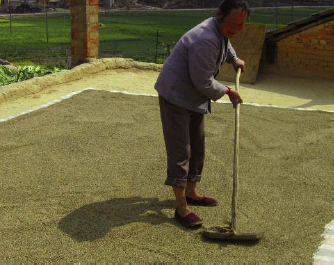
Yunnan woman spreading rice in the sun to dry, 2011.
It was Cantonese immigrants who opened the first Chinese restaurants in the U.S., which catered primarily to Chinese clientele. Americans slowly developed an interest in oriental foods, and some Chinese cooks began working in private homes. For these Cantonese Chinese, unadorned rice accompanied almost all their meals (rice is usually served plain in countries where it is the staple starch). What we call fried rice arose through the judicious use of leftovers. Today, fried rice can be ordered from menus as a dish on its own, representing an adaptation by and for non-Asians. After immigration laws were relaxed in the U.S. in 1965, Chinese diaspora immigrants from Taiwan, Hong Kong and Fujian expanded the definition of Chinese in New York, San Francisco, Los Angeles and other cities. Their rice dishes came with them.
If you celebrate New Years Day in Charleston, South Carolina, hoppin John will likely be a part of the meal. This traditional African meal of rice and cowpeas, or black-eyed peas/beans, comes from the culinary repertoire of West Africans. It was brought to the British, Dutch, French, Spanish, Portuguese and the as yet unnamed USA (where rice became a premier crop) colonies by slaves, as well as to some Caribbean islands, Brazil, Peru, Cuba and Mexico by the workers in sugar cane, cotton, tobacco, indigo and other colonial plantations. Indians also came as indentured labourers to the West Indies, followed by the Chinese and others. Rice, imported at first for slaves and labourers, became a commercial enterprise. If you eat hoppin John today, you are very likely to be of African or Caribbean descent, or both. And while you could be located in the southeastern U.S., the Caribbean islands or Mexico, you might equally be based in Detroit, Michigan, or Gary, Indiana.
You meet a friend for sushi and sake. Where are you? Tokyo? Perhaps, but wait: you hear Portuguese and English it turns out you are in So Paulo or London. Sushi is almost global in its urban reach, although it is a relatively late developer in the world of global rice-based foods. And consider the California roll. This inside-out roll, sometimes made with brown rice, includes avocado, cucumber, carrots, omelette and herbs, but no raw fish. California rolls are found on the menus of elegant Japanese restaurants in Singapore and Kosher restaurants in Shanghai. In culinary schools in Tokyo chefs are even taught how to prepare them properly.
While on the plane back to New York you read about famous rice-based meals in your in-flight magazine: paella, risotto, biryani and pilaf. These four rice meals are prepared at homes and in restaurants, at outdoor markets, on food trucks and at festivals; they are linked to Spain, Italy, India and Iran respectively. Recent historical research indicates that the origins of these dishes go as far back as the Moghul dynasties and Islamic traders.

